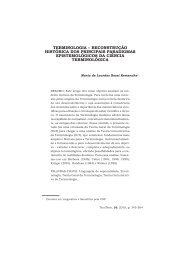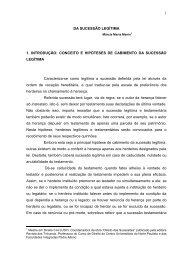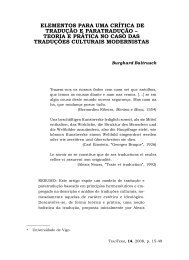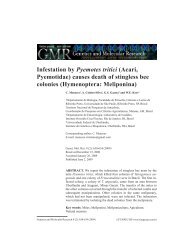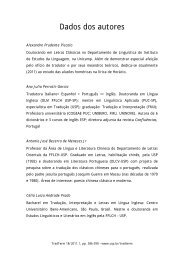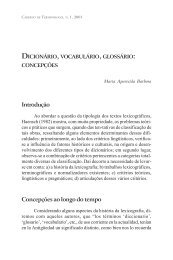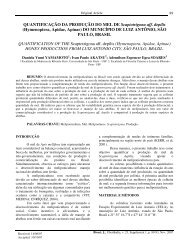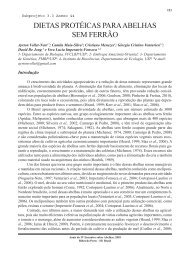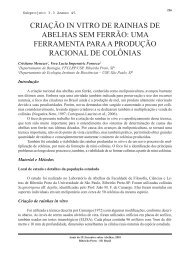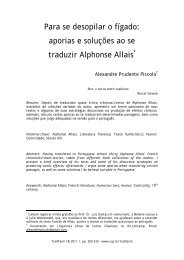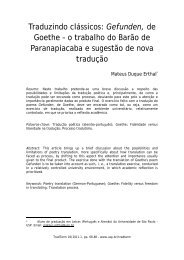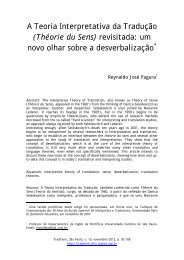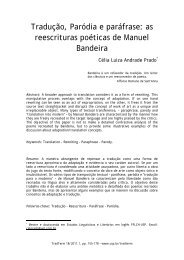Bees as pollinators in Brazil - USP
Bees as pollinators in Brazil - USP
Bees as pollinators in Brazil - USP
Create successful ePaper yourself
Turn your PDF publications into a flip-book with our unique Google optimized e-Paper software.
56<br />
various crop species are necessary <strong>in</strong> order for<br />
these bees to be used <strong>as</strong> large-scale reliable <strong>poll<strong>in</strong>ators</strong><br />
<strong>in</strong> <strong>Brazil</strong>ian agriculture.<br />
Solitary bee species<br />
Consider<strong>in</strong>g nest<strong>in</strong>g habits, solitary bees can<br />
be split <strong>in</strong>to two dist<strong>in</strong>ct groups:<br />
1. ground<strong>in</strong>g nest<strong>in</strong>g bees;<br />
2. cavity nest<strong>in</strong>g bees.<br />
Currently promis<strong>in</strong>g taxa to be worked on are:<br />
• Exomalopsis (there are reports of tomato<br />
poll<strong>in</strong>ation);<br />
• Epicharis (There are reports of West Indian<br />
cherry or acerola poll<strong>in</strong>ation);<br />
• Centris (There are reports of West Indian<br />
cherry or acerola poll<strong>in</strong>ation).<br />
Gr ound<strong>in</strong>g nest<strong>in</strong>g bees are difficult to<br />
manage; <strong>in</strong> most c<strong>as</strong>es there is no practical way<br />
to colonize are<strong>as</strong> with new nests, and merely<br />
provid<strong>in</strong>g suitable nest<strong>in</strong>g substrates (e.g. sand)<br />
rarely yields productive nest<strong>in</strong>g for many years.<br />
There is little knowledge about ground<br />
nest<strong>in</strong>g bees <strong>as</strong> <strong>poll<strong>in</strong>ators</strong> and about their<br />
management for this purpose. Three ma<strong>in</strong><br />
approaches are suggested to help identify<br />
potential poll<strong>in</strong>at<strong>in</strong>g bee species:<br />
1.selection of are<strong>as</strong> with less <strong>in</strong>tensive agriculture<br />
for visitation to crop species (e.g. home<br />
plant<strong>in</strong>gs of Cucurbita) where <strong>in</strong>secticide use<br />
is unlikely, so that bee populations can<br />
<strong>in</strong>cre<strong>as</strong>e without exterm<strong>in</strong>ation by pesticides;<br />
2.search for promis<strong>in</strong>g species of non-social<br />
<strong>poll<strong>in</strong>ators</strong> (or social Halictidae) on wild<br />
crops and their wild relatives (co generics).<br />
ex. Rhambutan, which is visited and poll<strong>in</strong>ated<br />
by Euglossa;<br />
3.<strong>in</strong>vestigate pollen use by any large aggregations<br />
where solitary bee species are found and<br />
discovered (e.g. Oxaea) to judge if they might<br />
be us<strong>in</strong>g flower<strong>in</strong>g species of agricultural<br />
<strong>in</strong>terest (e.g. aggregations of Peponapis).<br />
Recommendations<br />
In order to promote ground-nest<strong>in</strong>g bees that<br />
are effective and abundant <strong>poll<strong>in</strong>ators</strong> of a<br />
crop (or desired tree species) or of a close relative<br />
to this crop species, the farmer must manage<br />
the crop (care with spray<strong>in</strong>g, for <strong>in</strong>stance)<br />
and the surround<strong>in</strong>g land (size of monoculture<br />
acreage, proximity to fallow nest<strong>in</strong>g sites), <strong>as</strong><br />
these bees' nests cannot be moved, and artificial<br />
or "created" nest<strong>in</strong>g sites are unlikely to<br />
be reliably and quickly colonized.<br />
There is considerably more <strong>in</strong>formation<br />
on and well-succeeded examples of the use<br />
of cavity nest<strong>in</strong>g species of solitary bees.<br />
Species such <strong>as</strong> Osmia lignaria pronpiqua and<br />
Megachile rotundata are widely used and<br />
managed for apple (Malus domestica) and<br />
alfalfa (Medicago sativa) poll<strong>in</strong>ation, respectively,<br />
and their commerce amounts to millions<br />
of American dollars per year.<br />
Other promis<strong>in</strong>g taxa, such <strong>as</strong> Xylocopa,<br />
Centris, Megachile, Anthidi<strong>in</strong>i, Tetrapedia,<br />
already nest <strong>in</strong> artificial nest<strong>in</strong>g-sites and can<br />
potentially be managed to atta<strong>in</strong> large populations<br />
for use <strong>in</strong> poll<strong>in</strong>ation. Among these taxa,<br />
Xylocopa can be considered special <strong>in</strong> <strong>Brazil</strong><br />
because there is a demand for these bees and<br />
there is some knowledge on its biology and rear<strong>in</strong>g<br />
techniques for use especially <strong>in</strong> P<strong>as</strong>siflora<br />
plant<strong>in</strong>gs. Serious constra<strong>in</strong>s have been identified<br />
and must be overcome <strong>in</strong> order to achieve<br />
large scale production and economic viability for<br />
exploit<strong>in</strong>g these bees <strong>as</strong> crop <strong>poll<strong>in</strong>ators</strong>:<br />
• ants are serious predators of bee nests and<br />
must be controlled;<br />
• there is a need to elim<strong>in</strong>ate par<strong>as</strong>ites and<br />
dise<strong>as</strong>es (clean management) before establish<strong>in</strong>g<br />
populations for <strong>in</strong>cre<strong>as</strong>e;



